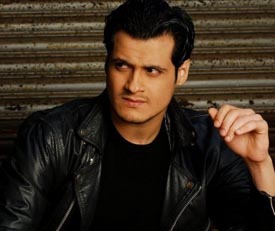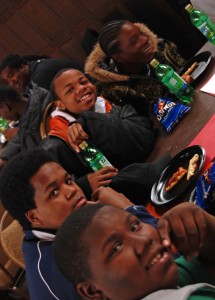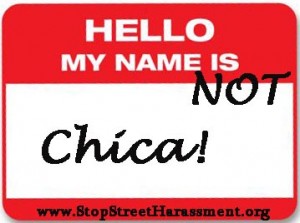This Blog is part of the Men Say No Blogathon, encouraging men to take up action against the violence faced by women. More entries to the Blogathon can be read at www.mustbol.in/blogathon. Join further conversation on facebook.com/delhiyouth & twitter.com/mustbol
When it comes to ending street harassment, men must be part of the solution. Fortunately, many men know this and are doing important work to say no to street harassment, including intervening when harassment occurs and raising awareness through writing and speaking.
My dad and my male partner frequently say no to street harassment by talking to other men about the issue and attending anti-street harassment events. This year my dad even represented Stop Street Harassment at two events and he always wants to know what more he can do (thanks, Dad!). They remind me every day that there are plenty of men out there who WANT to be part of this work, they’re just not sure how.
Here are some ways men are saying no, and you can find three campaign ideas to implement with young men at the end. Hopefully this information can provide examples to other men for taking action and inspire them to say no, too.
2 Men Intervene:
While many harassers only harass women when they are alone or they harass women in such a way that no one else realizes what is happening, there are many times when they do blatantly harass women in front of others. A bystander saying or doing something could make a big difference in ending the harassment scenario, helping the woman not feel alone and safe, and making it clear that the harassing behavior is socially unacceptable.
Here are two stories of men who’ve intervened.
1. When they noticed young men harassing a female university student walking by herself f in Delhi, India, Prakeet and his friend took action: “We hurriedly went to the girl, passing by the boys, and started walking by her sides and began joking about school life. At first she didn’t notice, perhaps because she was busy in figuring out how to get out of the mess she was in. Soon she noticed the halt in lewd remarks. The boys following her were still following us. I passed a smile to her and she returned it back. Within no time we reached Metro Station. Not saying much she thanked us for our help. We parted our ways. She went off to catch a bus while we took the Metro. This was the first time I ever took such a step and perhaps the first time I ever saw eve-teasing and dared to intervene before it could turn ugly.”
2. CJ, a man in Walsall, UK, shared how he intervened: “I walk to work with a friend and she has been shouted at, verbally harassed, had drivers slow down whilst passing her and, when in my car, other drivers make rude gestures and shout at her…The worst behaviour has been from the contractors working on the roadworks outside our office. After reading some of this website last night, I went over to the workmen, whilst they were staring and letching at my friend and told them to stop as it was threatening and unwelcome. I then went back into the office, called the company involved and reported the complaint to the director and backed it up with an email. I have received an email response stating that they would investigate my complaint and proceed with disciplinary action where appropriate. My friend was scared and didn’t feel able to say anything to the contractors; I asked her if it was OK for me to speak up for her and she said yes.”
7 Men Write:
Raising awareness through blogging, tweeting, Facebook posts, and articles can help raise awareness that street harassment happens and that it’s not okay. Men sharing this information with their guy friends is so important.
This year, many men wrote eloquent posts for the Stop Street Harassment male allies series:
1. “While most men I encounter on a daily basis, to my knowledge, do not harass on the street, most that harass are men. As men, our silence is deafening and we continue to ignore the canary in the mine which says our community needs to deal with issues of gender and power. Until we see street harassment as the problem that it is, we’ll continue to live in our neighborhoods like the miner who labors in a mine with a dead canary, until it’s too late to get to safety.” Read the full post.
By: Dr. L’Heureux Dumi Lewis, Assistant Professor at the City College of New York
 2. “Irrespective to what your ‘friends’ think always question your own double standards and attitudes. Avoid laughing at sexist jokes simply to humor them reminding yourself you might offend someone. Do not repeat what your fathers did. Believe me there is no place in the Men’s community for perverts.Your attitude towards strangers reflects your upbringing at home. Besides you wouldn’t want your mother or your sister to go through the exact same thing.” Read the full post.
2. “Irrespective to what your ‘friends’ think always question your own double standards and attitudes. Avoid laughing at sexist jokes simply to humor them reminding yourself you might offend someone. Do not repeat what your fathers did. Believe me there is no place in the Men’s community for perverts.Your attitude towards strangers reflects your upbringing at home. Besides you wouldn’t want your mother or your sister to go through the exact same thing.” Read the full post.
By: Mohnish Moorjani, founder of Shoot At Sight
3. Read views from young men like Sean Crosbie, Nicklaus Weinheimer, Christopher Smith, and Relando Thompkins who contributed to the Stop Street Harassment male allies series.
4. Yashar Ali wrote a wonderful piece for Huffington Post about street harassment which spread widely via social media. It is called, “Men Will Never Truly Understand a Day in the Life of Women — But Shouldn’t We Try?”
3 Men Speak Out:
Quite a few men are publicly speaking out about street harassment. This is also very important to help bring attention to the issue and change its social acceptability.
1. Hear what Jesse Morgan in Baltimore has to say:
2. Joe Vess from Men Can Stop Rape gave a talk about it:
3. The Astronomical Kid is probably the most well known:
3 Great Campaigns:
 1. Are you on a college campus? Order Men Can Stop Rape’s new bystander campaign, Where Do You Stand? It includes information and a poster on street harassment.
1. Are you on a college campus? Order Men Can Stop Rape’s new bystander campaign, Where Do You Stand? It includes information and a poster on street harassment.
2. Do you work with teenage boys? Use Young Women’s Action Team’s new toolkit, Where Our Boys At? A Toolkit for Engaging Young Men as Allies to End Violence, created after they conducted surveys and focus groups with boys.
3. Are you a mentor to a young man or young men? Download the Coaching Boys into Men toolkit, produced by Futures Without Violence. It includes lessons on street harassment.


